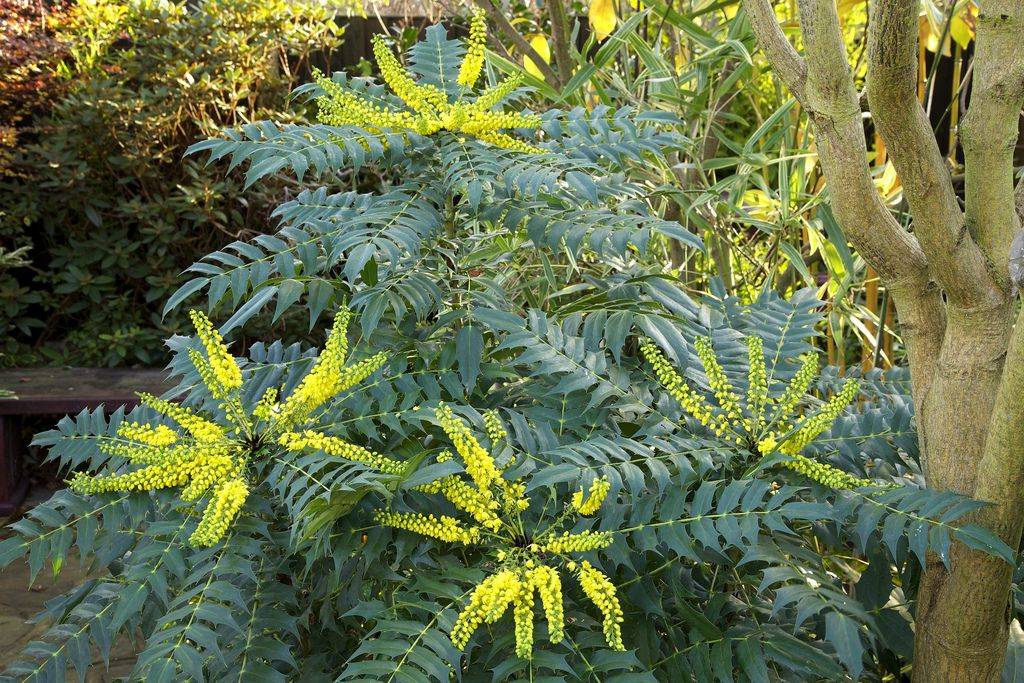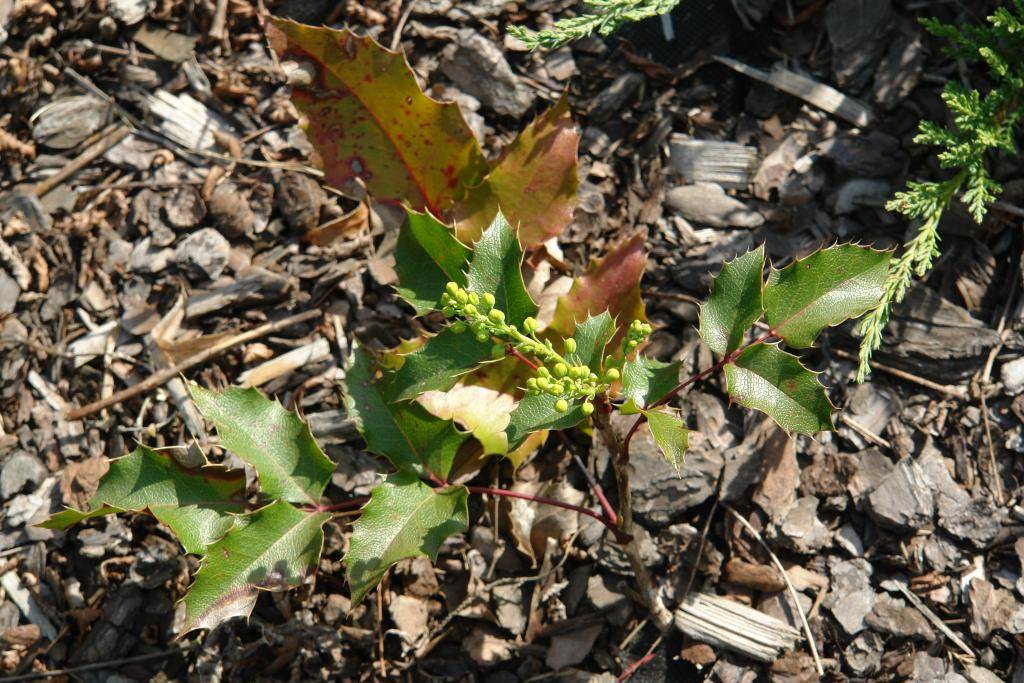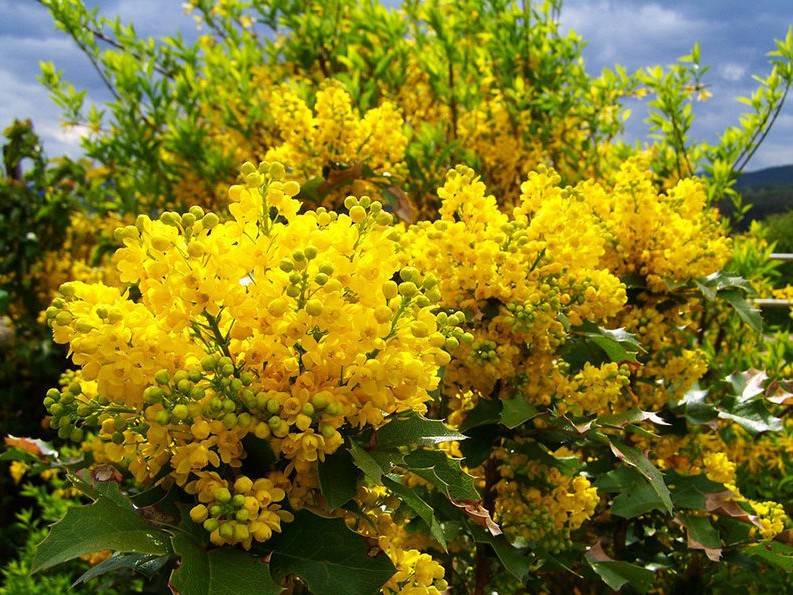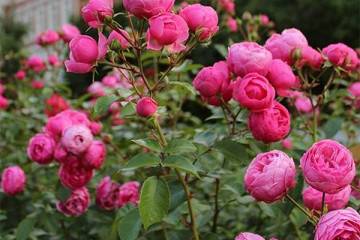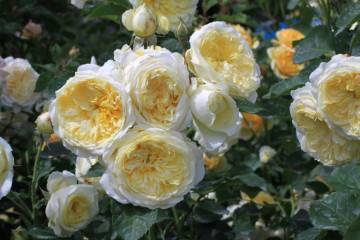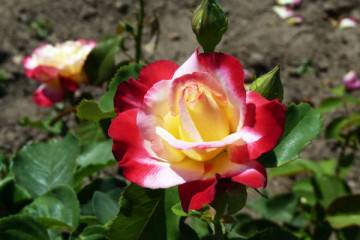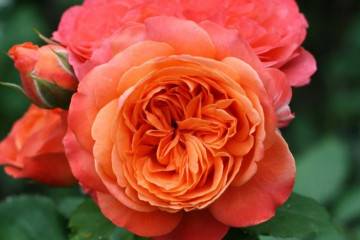Mahonia aquifolium - all about shrub breeding
Content:
Mahonia holly - an evergreen shrub or small tree, which is not very common in Russia. Its spread on the territory of the country is just beginning. However, gardeners who have already started growing the plant are very pleased with it. Magonia pleases fans of floriculture all year round: beautiful glossy leaves, bright flowers that resemble the usual mimosa and dark berries, which are also edible. The plant is not very whimsical to care for, even a beginner will be able to grow it.
What does Mahonia holly look like?
Mahonia holly belongs to the barberry family. During the flowering period, it can resemble mimosa from afar, but they are similar only in bright yellow flowers, collected in lush inflorescences. Otherwise, the two flowers are radically different.
The homeland of the plant is the American continent. The flower owes its name to the Irish botanist B. McMahon, who transported it from west to east of the United States. Since the United States is a country with a difficult climate, and this plant is common in all its parts, we can say that it is very hardy. Mahonia began to be cultivated as a decorative culture in America at the beginning of the 19th century, later it spread to the European continent. Natural habitat - all of America from Colombia to southern California, the North Caucasus, Ukraine, the Baltic states.
Plant characteristics
Botanical Description of Magnesium Holly:
- maximum height - 1 m;
- erect stems, gray bark;
- leaves 15-20 cm long, leathery, glossy, sinewy, dark green, with jagged sharp edges;
- leaves turn purple in autumn and return to standard green in spring;
- flowers are small, bright yellow, collected in panicle inflorescences;
- at the end of flowering, dark blue small berries appear in place of the leaves, which are edible.
What are the varieties of Mahonia
The entire genus of Mahonia consists of 50 species, some of them do not occur in natural conditions, being exclusively garden plants. There are several varieties of holly Mahonia:
- Walnut. The leaves are located on red petioles, consist of 7 simple leaf plates. The leaves differ from the parent species in smaller sizes.
- Graceful. The leaf plates of the graceful Mahonia are longer than the leaves of the parent species.
- Golden. Leaves are yellow-golden all year round.
- Variegated is characterized by multi-colored leaves.
Species of Mahonia holly occurring in nature
Some plant varieties are found most often only in nature, and 1-2 hybrid varieties are grown in a garden.
Magonia creeping (Mahonia repens)
Magonia creeping is common throughout the northern part of the American continent. This is a creeping plant up to half a meter high. Leaves are complexly dissected, consist of 5-7 small parts. The length of each part is 3-6 cm. The color of the leaves is blue-green, they are devoid of the usual gloss, they have a matte surface. The edges of the leaves are serrated.
The inflorescences are not very long, their size can be 3 cm, but some grow up to 10 cm. The berries are about 1 cm in size, bluish-black, pubescent. Flowering occurs in late spring and fruiting in early autumn.
Mahonia japonica
Mahonia Japanese is called so for a reason. Obviously, her homeland is the Land of the Rising Sun. This species does not occur in nature. The plant is a tree up to 4 m high. The branches of the variety are erect, branching very little. The leaves are large, can reach half a meter in length, grow in clusters on the tops of the shoots, consist of several simple leaves. Inflorescences - panicles up to 20 cm in length. The scent of the flower is similar to the scent of lily of the valley.
Mahonia Winter sun
Winter Sun is a hybrid variety resulting from crossing the Lomarielle and Japanese varieties. The maximum height is 2 m. This variety is difficult to grow in Russia, since it got its name due to the flowering period. The winter sun only blooms in winter.
Mahonia Fremontii
A tall shrub found in the western United States. It grows up to 3 m in height. The leaves have an unusual grayish color. The flowers are pale, which is also not typical for representatives of the genus. The fruits are bright red. Leaves change color depending on age. Young leaves are reddish, adults are deep green, and wilting, old leaves become grayish, bluish in color.
Mahonia bracts Soft Caress (Mahonia eurybracteata Soft Caress)
The variety was bred in China, it is grown there and in Japan. Differs in high decorativeness and narrow long lanceolate leaves. This plant is popular for container growing. The variety has received many awards at various international exhibitions.
Mahonia Neubertii
This variety is a hybrid obtained by crossing the holly Mahonia and the barberry. It is an evergreen shrub with high decorative properties. Height - up to 1 m. The ovoid leaves resemble barberry leaves, but the stems are devoid of thorns.
Most popular varieties with gardeners
Some plant varieties enjoy the special disposition of flower growers. They are most commonly found in gardens.
Magonia Apollo
This variety was bred in the Netherlands in 1973. It is a compact bush with a height of about 60-100 cm. The leaves are long, up to 30 cm. Each leaf consists of 5-7 parts. Leaves change color from green to burgundy by autumn. The flowers are bright yellow, fragrant. The berries are dark blue with a waxy bloom.
Magonia Atropurpurea (Autropurpurea)
The variety is also bred by Dutch breeders. The bushes are compact, the height and width are approximately the same - about 60 cm. The leaves are dark green, glossy, about 25 cm. The flowers are bright yellow, the berries are dark blue.
Magonia Smaragd
Sprawling variety, up to 1 m wide and the same in height. The leaves are pinnate, compound. Dark berries are edible and are actively used in the confectionery art.
How does Mahonia holly reproduce?
Propagation of holly mahonia is carried out by cuttings, dividing the bush, layering and seed method.
Cuttings
For harvesting cuttings, exclusively young plants are chosen, since parts of the stems of adult bushes will not take root. They are cut in early spring before the buds have time to swell. Each stalk should have 6 buds. They are immersed in vessels with water so that the liquid covers them by half. These containers are put directly into the garden. After about 2 months, the lower buds that are in the water will sprout. After they grow up, reach about 7 cm, they can be planted in open ground, covered with plastic bottles on top. After 2 weeks, the bottles are removed completely, a week before they are left only overnight. This is necessary in order for the young Mahonia flower to get used to the environmental conditions.
Dividing the bush
Mature plants can be propagated by dividing the bush. This must be done very carefully. The bush is dug up, the rhizome is divided, rotten, dried and damaged roots are removed. All cuts are sprinkled with crushed charcoal. Parts of the bush are transplanted to a new location.
Layers
To propagate the plant in this way, a strong shoot is selected in the spring. It must be bent into the groove, which must be prepared in advance, and fixed in this position.
Systematically, the branch must be watered. A new young plant will be ready only a year later, next spring. Then it can be separated and transplanted to a permanent place.
Growing from seeds
Florists, of course, are interested to know whether and how Mahonia can be propagated by seeds. This method is possible, but it is a rather lengthy process, which, moreover, does not always give a result.
Seeds are sown in open ground immediately after harvest. They must be fresh. Seeds can be sown in spring, but in this case they must be stratified for 4 months. Suitable temperature is from 0 to +5 degrees.
The seeds are also used for growing seedlings. In this case, the crops need to be provided with warmth, humidity, and long daylight hours. Until the seeds begin to hatch, containers with them can be covered with glass or plastic wrap. The shelter must be lifted regularly to ventilate and moisturize the soil. After about a year and a half, you can transplant the matured seedlings into open ground.
During the first 2-3 years, the seedlings must be especially carefully wrapped for the winter. Spruce paws and special garden insulation are suitable as a shelter.
Features of care in the garden
Care and cultivation of Mahonia holly will not cause much trouble. Experienced flower growers can handle the cultivation especially easily.
What conditions do Mahonia like
Despite its undemandingness to certain living conditions, oakleaf Mahonia like:
- fresh, slightly acidic, well-drained soil;
- calm areas;
- periodic feeding and weeding;
- regular watering, especially during drought.
Taking care of a flower is quite simple, but there are still some nuances.
What is the plant afraid of
The bush simply does not tolerate some things:
- gusts of cold wind and drafts;
- stagnation of moisture in the soil;
- drought;
- direct sunlight.
Also, do not prune the bush too often.
The soil in the area where Mahonia grows should be fresh, with good drainage, low acidity, and rich in nutrients. The optimal composition of the soil mixture:
- 2 parts of humus;
- 2 pieces of turf;
- 1 part sand.
The groundwater level should not be too high.
In summer, especially when it is dry, hot weather, it is necessary to water the flower as the soil dries out. If there is a lot of rain in the summer, watering is not required at all.
It is enough to feed the plant twice a season. The first time is right after the snow melts. For this, complex mineral fertilizers are suitable, preferably nitrogenous. Thanks to them, the flower will begin to grow green mass sooner. The second time fertilizers are applied before the flowering of the bush in late spring. You can use "Nitroammofosku".
Preparation for wintering
It all depends on the age of the plant and the region of cultivation. Young bushes should be wrapped very carefully. Adults have high winter hardiness, so they practically do not need shelter, they will have enough snow. If a cold and snowless winter is expected, it is worth covering the Mahonia with spruce paws and a special cloth. This is especially true for plants living in the middle lane.
When and how it blooms
The flowers of Mahonia are small, bisexual, collected in fluffy panicle inflorescences. Inflorescences are formed in the leaf axils. The flower consists of 9 sepals and 6 stamens. The shape of the flowers is round, regular, the petals are arranged in two circles.
The flowering period depends on the variety, most often it occurs in May-early June. Some hesitation is possible. Duration is about a month. No care changes are required during the flowering period.
Possible growing problems
Mahonia holly has a high immunity to most diseases. But sometimes it can be attacked by both diseases and some pests.
Diseases:
- powdery mildew;
- spotting;
- phyllosticosis;
- rust.
Either spring preventive spraying or special insecticides sold in all flower shops will help get rid of them.
Signs of improper care
Magonia does not immediately let you know about improper care, it is a rather patient shrub. But if problems arise with the leaves, buds are not tied, flowers fall, berries are small or none at all, then it's time to take action. You need to review all the care procedures and correct your mistakes.
Use in landscape design
Bright, interesting and picky Mahonia holly is actively used in landscape design. It is often used in urban plantings, since it copes well with high air pollution. Magonia looks great as a curb plant and is often planted as small hedges.
Mahonia holly is a plant, the attitude towards which, for sure, will soon change. The flower will gain real popularity due to its decorative qualities and internal characteristics. A bright, interesting flower that retains its beautiful appearance throughout the year cannot go unnoticed.



